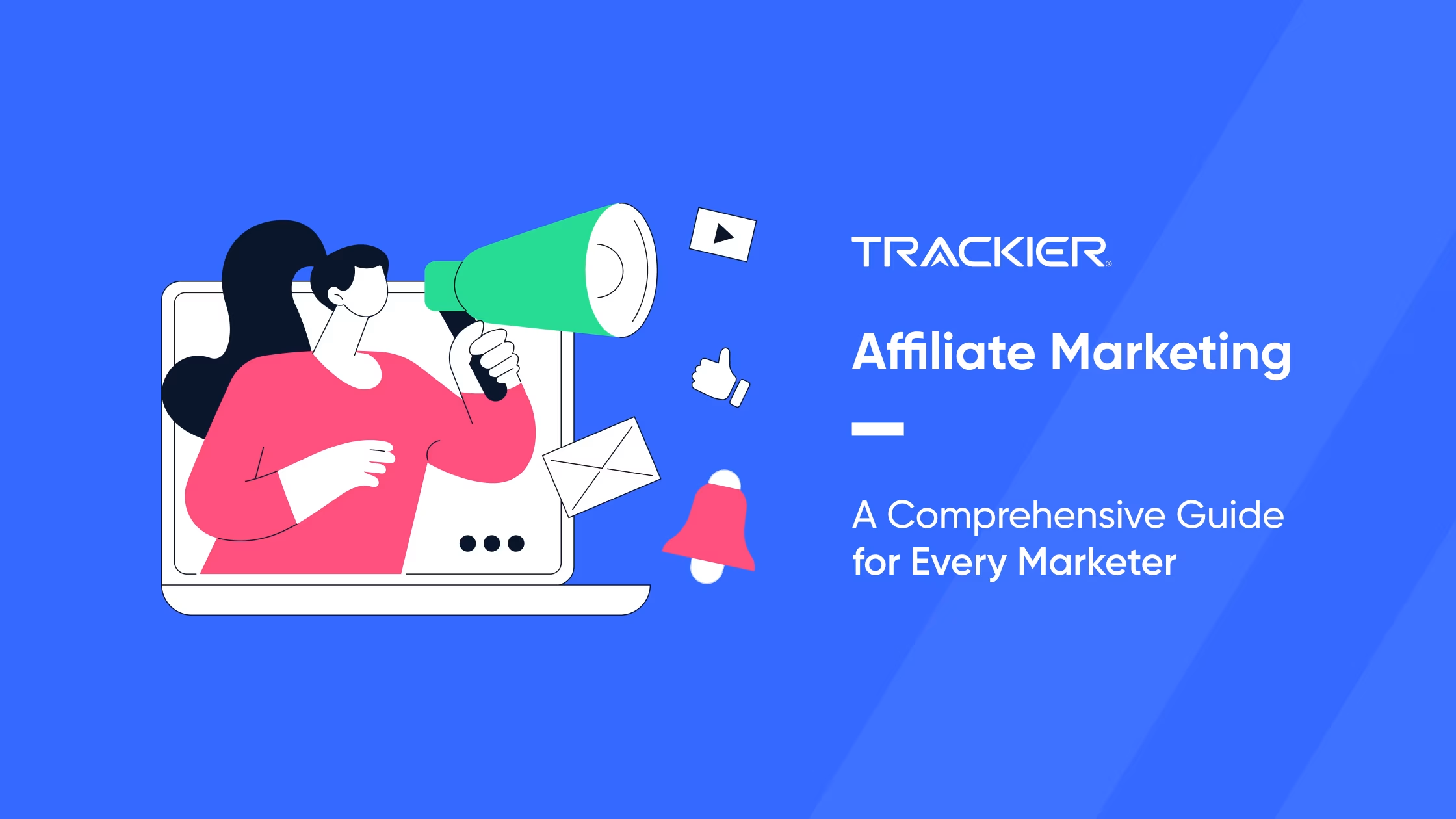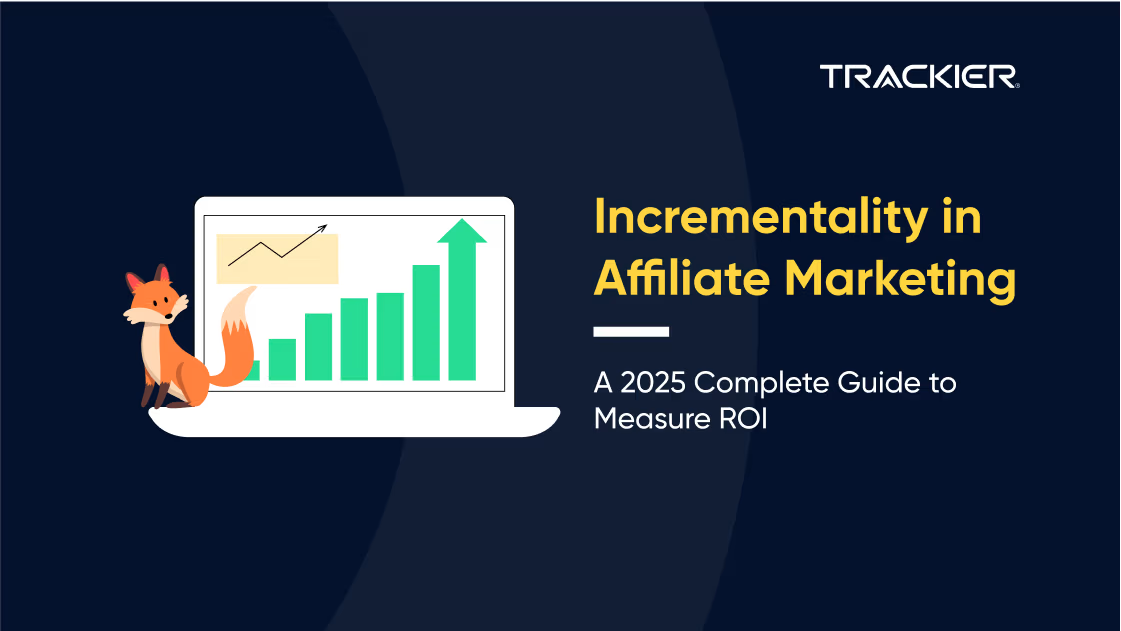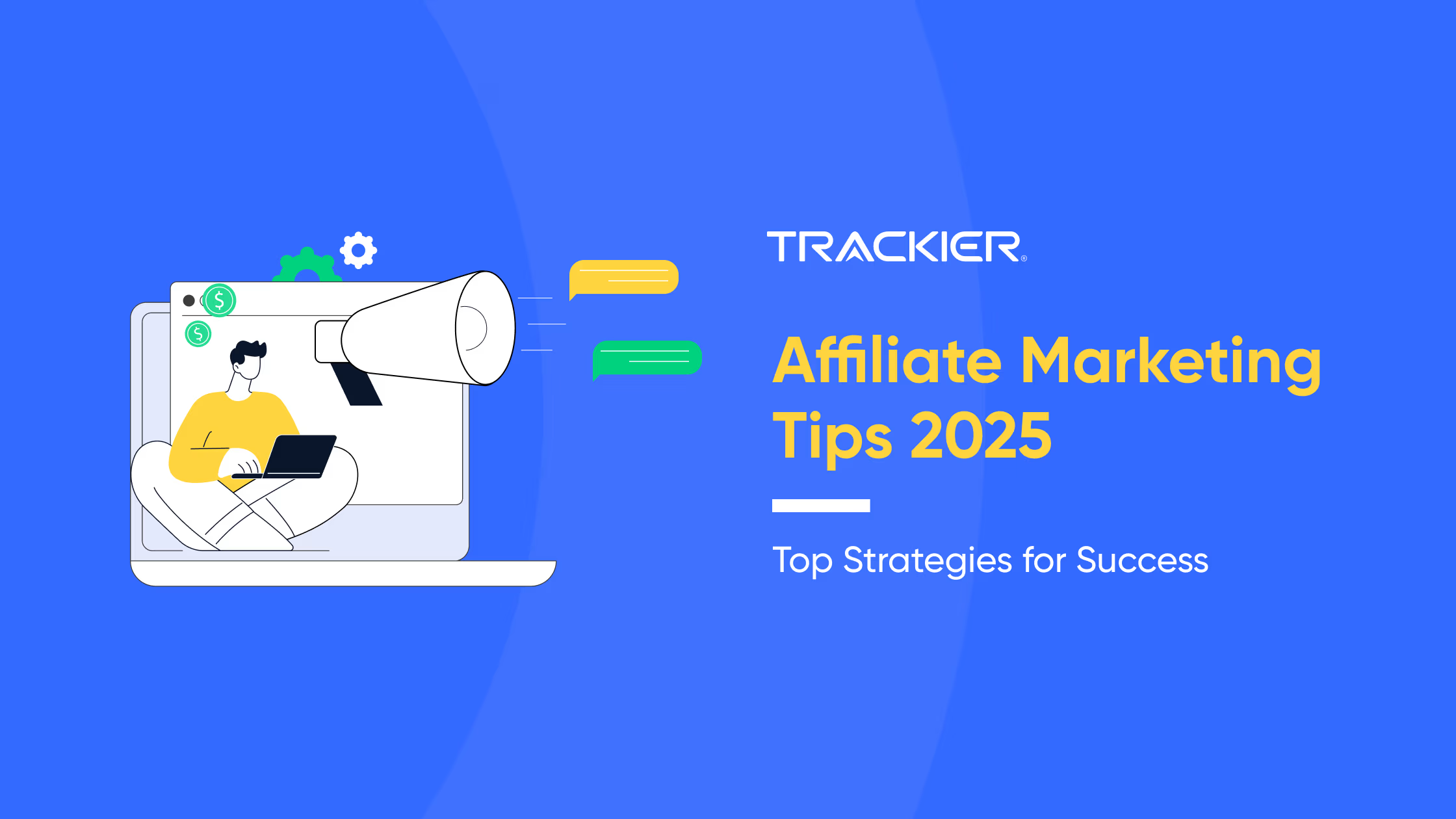Affiliate marketing is revolutionizing the way brands connect with audiences, delivering measurable results while optimizing marketing spend.
In 2025, the affiliate marketing industry is projected to exceed $10 billion in spending in the U.S. alone, reflecting its rapid adoption by 81% of brands worldwide.
Trackier helps businesses to efficiently manage affiliate partnerships, monitor real-time performance, and maximize ROI with precision.
Whether you’re a brand seeking growth or an affiliate aiming to monetize your influence, Trackier is your strategic partner in unlocking affiliate marketing’s full potential.
What is Affiliate Marketing?
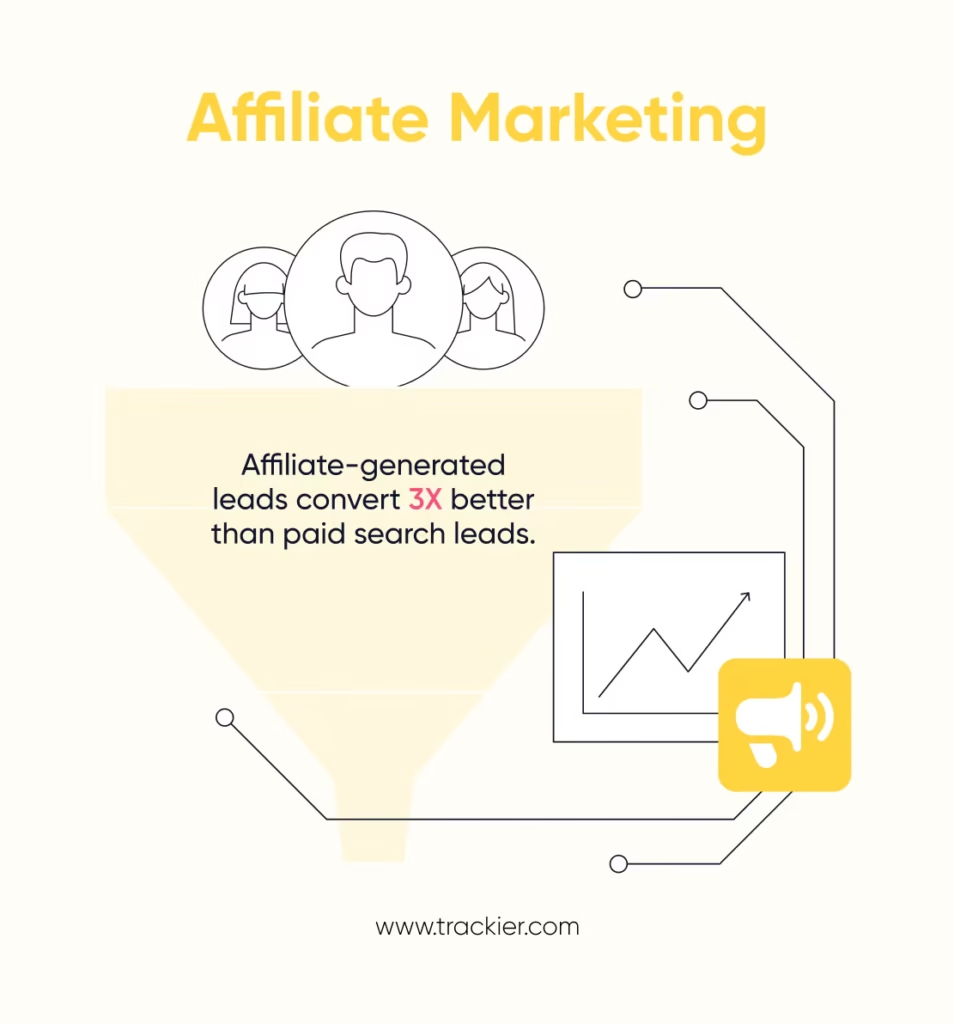
Affiliate marketing is a marketing strategy in which a brand collaborates with affiliates, marketers who promote the product or service, and get paid when someone purchases, subscribes, or takes action via their affiliate link.
More than 80% of brands now use affiliate programs to reach new consumers, making it one of the most effective affiliate marketing strategies for driving sales through trusted partners
It is a smart strategy for businesses to reach new consumers via trusted sources from bloggers, YouTubers, influencers, and content creators without spending a huge marketing budget on traditional marketing.
- It helps businesses expand their reach and sell more products/services with low resources or budget.
- It helps affiliates earn money by recommending a product or service they trust.
- It also helps a consumer use a brand with useful information from creators they are already following.
Benefits of Affiliate Marketing
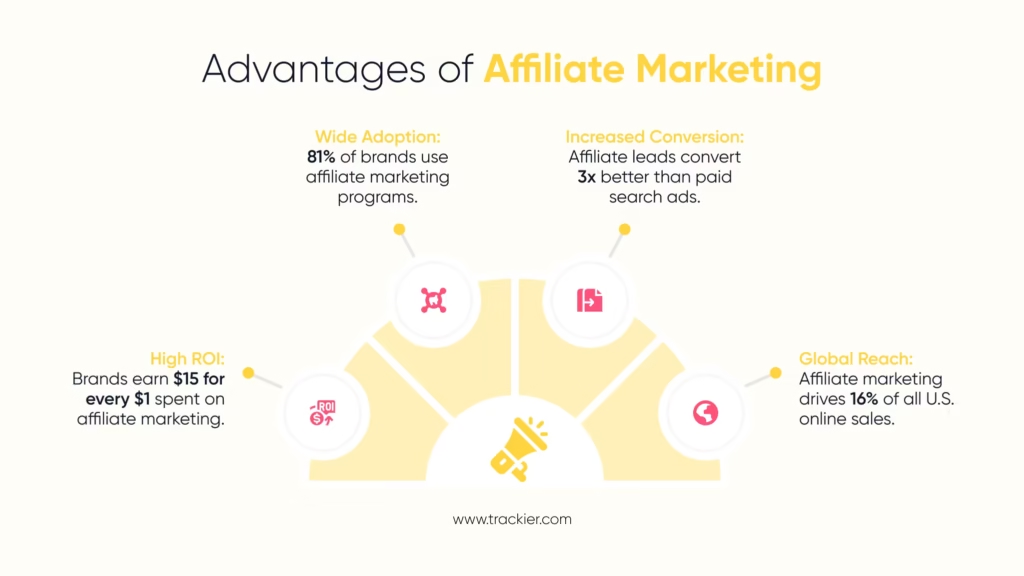
Affiliate marketing has become one of the most successful and cost-effective strategies for digital marketing for businesses of all sizes. For example, brands using affiliate marketing earn an average of $6.50 for every $1 spent.
It allows brands to reach new audiences and build trust, thus generating measurable revenue, while preserving predictable and performance-based marketing dollars. In fact, affiliate marketing drives around 16 percent of all e-commerce sales in the U.S. and Canada.
Below are some of the most important benefits of affiliate marketing and why it remains one of the most powerful affiliate marketing strategies to include in your overall plan:
1. Performance-based ROI
When comparing it to traditional advertisements that require a payment for impressions and/or clicks without a guaranteed result (conversion), affiliate marketing is pay-for-performance advertising, meaning you only pay the affiliate for a specific action, usually a sale, lead, or sign-up.
This means that your budget spent through affiliate marketing directly results in a measurable outcome, making this advertising channel a high-ROI marketing experience and one of the most data-driven affiliate marketing strategies available.
2. Expanded Market Reach
Through affiliate partnerships, brands can immediately access new markets and niche audiences that would take years to get to organically.
Affiliates – as bloggers in your niche, influencers who have built their audience, or comparison websites that feature various offerings- have built a community that trusts their recommendations.
Businesses can build awareness among highly targeted audiences through well-planned affiliate marketing strategies, often spanning multiple geographies and demographic segments.
3. Cost-Effective Customer Acquisition
Affiliate marketing lowers the upfront risk often associated with traditional advertising. Since reading an ad doesn’t guarantee conversion, you can avoid the risk of wasted expenditure; you only pay when the affiliate brings you a customer.
For start-ups and fast-growing eCommerce brands, affiliate marketing represents a cost-effective way to attract customers without sacrificing quality, making it one of the smartest affiliate marketing strategies for scaling growth.
4. Increased Trust and Credibility
Today’s consumers seek authenticity. When you purchase a product recommended by a trusted creator or an expert in your field, it feels more like a friend’s endorsement or recommendation than an advertisement.
Third-party validation boosts your brand credibility and builds trust in your brand, which increases the chances of conversion. When executed consistently, affiliate marketing strategies centered around authentic creators can lead to long-term brand loyalty.
5. Scalable and Flexible
Affiliate marketing programs offer great scalability. Brands can start with just a few affiliates and scale into hundreds or even thousands of affiliates as their business grows.
Because each affiliate runs their own channel and promotional efforts (like blogs, video channels, or emails), brands can scale their efforts quickly without growing their internal business costs or their advertising spend; another advantage of flexible affiliate marketing strategies.
6. Insights and Optimization Based on Data
Thanks to advanced tracking and attribution, brands are able to see performance metrics in real time, from click-through rates to conversion values.
These insights allow marketers to better understand which affiliates are performing the best, optimize campaigns accordingly, and remove fraudulent or under-performing traffic sources.
7. Complements Other Marketing Channels
Affiliate marketing does not work solo; it helps improve the entire marketing ecosystem. By complementing SEO, text marketing, influencer marketing, and content marketing, affiliate marketing helps you keep consistent messaging after initiating campaigns.
It also helps to drive prospects down the conversion funnel, and is a great way to increase your reach and strengthen brand authority.
8. Win-Win for Both Parties
One of the reasons that affiliate marketing has been around for many years is that it is beneficial for both parties.
Brands get sales and more exposure with less risk, while affiliates earn revenue for their creative abilities and influencer position. This synergy leads to sustainable relationships and sustainable growth.
9. Increased Conversion Rate
Often, an audience from an affiliate has some level of pre-qualified leads who are already interested or connected to that particular niche.
Because they are led by their recommendations from trusted sources, conversion rates are typically much higher than utilizing traditional display or search ads.
10. Worldwide Potential
Affiliate marketing has no limits. Brands can work with affiliates across global regions and local languages to reach audiences, all seamlessly tracked through a central dashboard.
With the industry projected to grow significantly (e.g., to nearly $31.7 billion by 2031), global scalability is clearly part of the future.
This opportunity for global scalability makes it a powerful channel for brands that are testing new markets without having to heavily invest in local advertising.
How Does Affiliate Marketing Work?
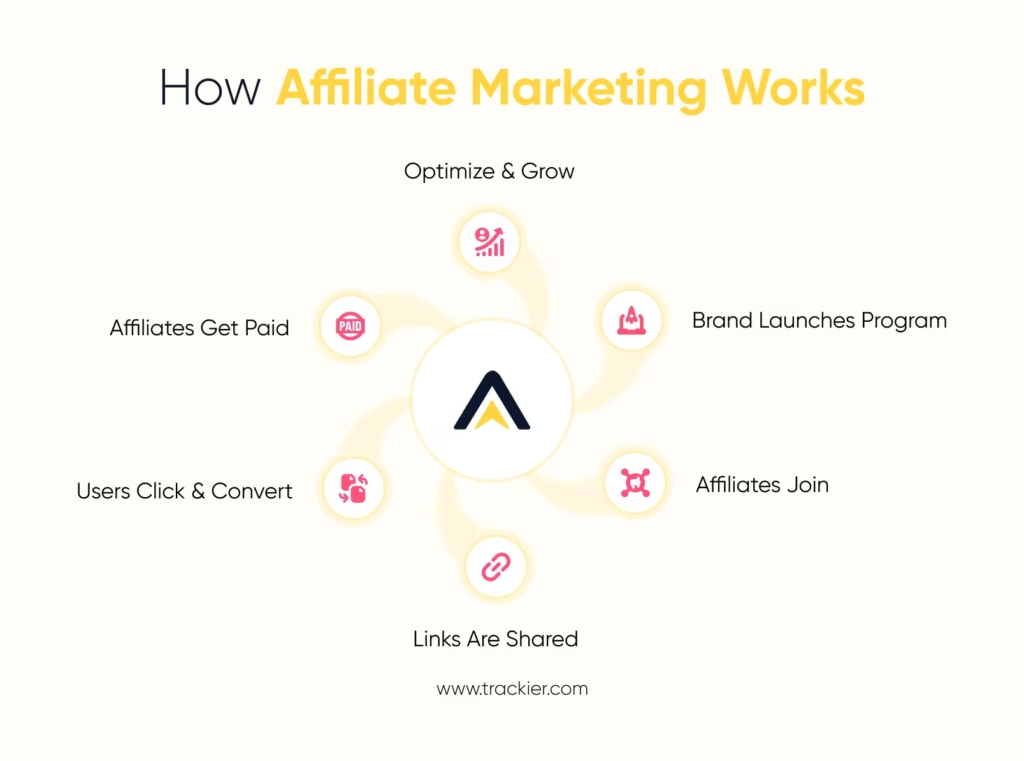
Affiliate marketing is a very simple but profound concept within the affiliate business model. It is a win-win scenario: brands get to promote and market their product or service through trusted promoters, and affiliates are compensated for any conversions that they had a direct role in influencing.
Let’s break down how the affiliate business model works step by step.
1. The Brand (Advertiser) Launches an Affiliate Program
A business, whether that is an e-commerce store or a SaaS company, creates an affiliate program, and the affiliate program will include:
- The commission structure (either a percentage of sales or a fixed payout).
- The tracking method (either unique links, coupon codes, or UTMs).
- Terms and conditions (Eligible products, payment cycle, and how the affiliate is permitted to market).
This step establishes the foundation of the affiliate business model, where brands provide the structure and affiliates act as the performance-driven marketing partners.
2. Affiliates Sign Up and Receive Unique Tracking Links
Once accepted into the affiliate program, affiliates receive their unique tracking links that are associated with the brand’s website or landing pages. The links are what make affiliate tracking measurable.
When an affiliate shares the link to promote a product via a blog post, YouTube video, email newsletter, or social post, the affiliate tracking link allows the brand to understand where the clicks, leads, or purchases were generated from.
Trackier provides even deeper insights by measuring:
- Clicks, impressions, and conversions
- Conversion attribution models
- Device, source, and region-level data
3. Affiliates Share the Affiliate Links
Affiliates then share and use these links in their content in any number of genuine ways, including:
- Writing reviews or tutorials of the product
- Making a comparison video
- Recommending a tool in a newsletter
- Embedding product links in blog posts
This add-on does not feel like a spammy ad and feels organic and trust-based to the audience. This context improves engagement and conversion rates, one of the core strengths of the affiliate business model.
Example: A technology blogger might write an article title “Best Website Hosting Platforms for 2025,” and then embed affiliate links for website hosting providers. If those readers click through and purchase, the tech blogger earns a commission.
4. Tracking, Attribution, and Conversion
Every time an end user clicks on an affiliate link, the browser records that event in different ways, by way of:
- Cookies (for short-term tracking, generally 30 to 90 days)
- Postback URLs or pixels (server-to-server tracking and accuracy)
If that customer took an action that qualified (like purchasing or starting a trial), the affiliate’s ID contained in the tracking link will attribute the conversion to them.
Even Trackier will assist brands in preventing fraudulent activity for tracking accuracy and proper payment of commissions, ensuring the affiliate business model runs transparently and efficiently.
5. Commission Payouts
The affiliate will get paid after the conversions are verified. They will earn based on the agreed payment model, such as:
- CPS (cost per sale) – earn a predetermined percentage of each sale
- CPL (cost per lead) – get paid for producing qualified leads
- CPA (cost per action) – get paid for a specific action, such as downloading an item or signing up
6. Continuous Optimization
Affiliate marketing is not a one-and-done effort; it is an ongoing process of taking action, analyzing, and optimizing your outreach.
- Brands identify affiliates with the highest conversion rate and often provide exclusive offers or creative materials to these affiliates.
- Affiliates are able to source content or traffic that receives the highest conversion rate, and over time, they are able to optimize a strategy.
Key Players in Affiliate Marketing
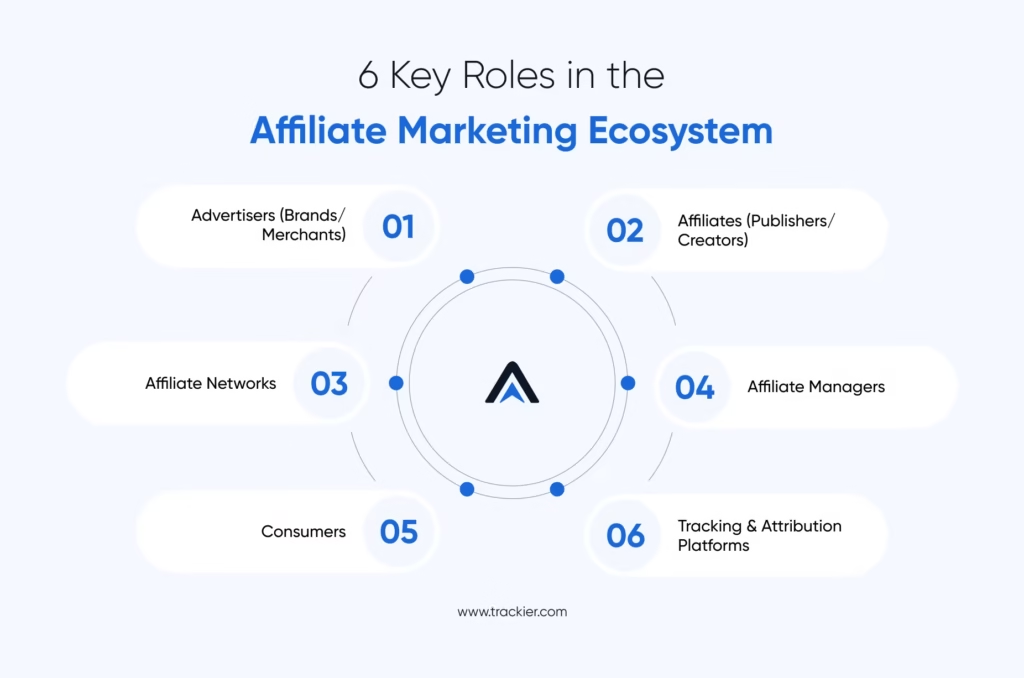
Affiliate marketing is a strong network that consists of multiple moving parts. Every player serves an essential role in producing effective performance, tracking results, and providing transparency.
The first step to running a productive affiliate business model is understanding who the key players are and how they come together.
1. Advertisers (or Merchants)
These are the brands, businesses, or owners of the products that would like to promote their including product offerings, through an affiliate relationship.
They start an affiliate program to promote their products to a different audience, create conversions, and only pay commissions when an action or result is delivered.
Examples may include e-commerce brands, SaaS companies, or online retailers that will offer commissions through their affiliate program to help promote their products.
Why does it matter? Advertisers are responsible for the affiliate product, performance goals, and commissions, forming the foundation of an affiliate campaign.
2. Affiliates (or Publishers)
Affiliates are the marketers, content creators, or influencers who are promoting the advertiser’s products or services. This can be through the use of blogs, YouTube channels, email lists, and social media platforms.
Affiliates then earn a commission for any sales, leads, or actions created through their unique affiliate link.
Example: A tech blogger who recommends web hosting services or a finance YouTuber who reviews an investment app.
3. Affiliate Networks
Affiliate networks are intermediaries between advertisers and affiliates. They provide multiple affiliate programs in one platform and manage all aspects of them (tracking, payments, etc.).
Importance: Networks provide simplicity to campaign launching, tracking, and partner onboarding, and simply allow brands and affiliates to connect and grow.
Pro Tip: Sure, affiliate networks are a great way to gain access, but they are incredibly expensive and limited in customization. This is Trackier, come as a better choice.
4. Affiliate Managers
Affiliate managers look at an affiliate program’s day-to-day practices. They recruit affiliates, communicate with affiliate partners, analyze and report performance data, and monitor compliance with campaign directives.
Importance: They keep the program on track with the desired business objectives and support affiliates in real-time through support, creative assets, and data-driven insights to improve performance.
5. Consumers
Consumers are the last, but just as important, part of the affiliate marketing cycle. They engage with affiliate content, click links, and ultimately purchase the product/service.
Their trust in the affiliate’s recommendation directly impacts the conversion.
Importance: Affiliate marketing relies on trust and authenticity, and a consumer rewards that with commitment and engagement.
6. Tracking and Attribution Platforms
This is where you have the magic of measurement and performance. Trackier allows advertisers, agencies, and networks to track every click and conversion, commission, ad fraud control, multi-touch attribution, and real-time analytics to optimize ROI.
Importance of Trackier in this ecosystem:
- Provides advertisers with complete control of tracking and performance by the partner.
- Provides transparency and accuracy in attribution across channels.
- Allows for payout to the affiliate each month, detection of click fraud, and details into what is working and what is not working.
- Provides comprehensive data for affiliate networks and agencies to grow and scale globally.
Types of Affiliate Marketing
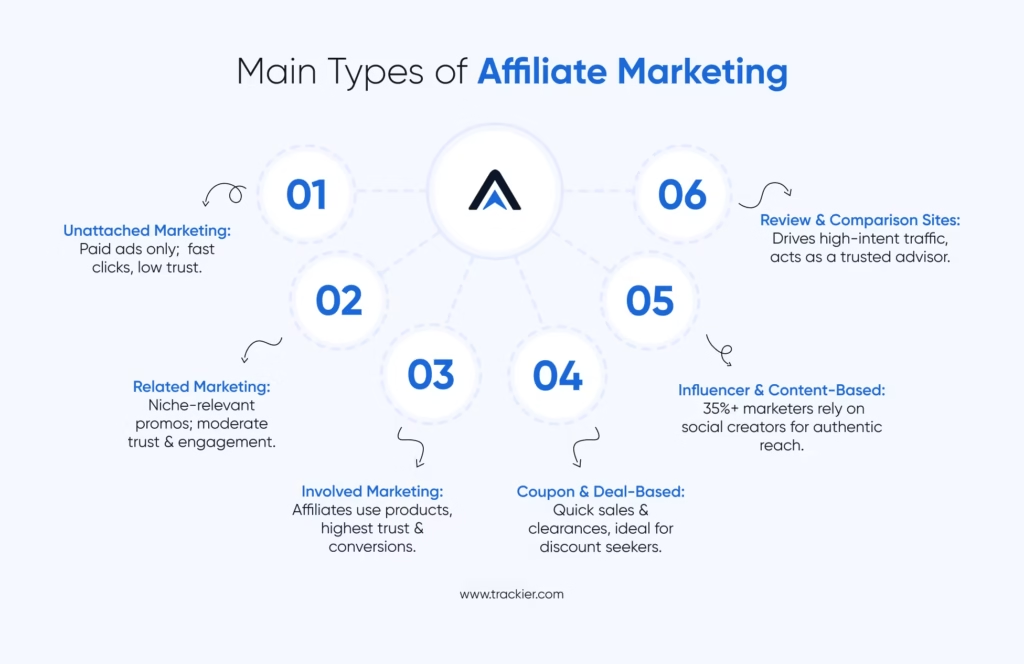
Over the years, affiliate marketing for businesses has taken on various forms that are suited to different businesses, audiences, and marketing purposes.
By knowing these forms of affiliate marketing, brands can determine the appropriate strategy for partnerships, and affiliates can decide how to monetize their audience.
1. Unattached Affiliate Marketing
In the unattached affiliate structure, affiliates introduce brands and products without any true authority or affiliation in that category.
In this type of affiliate marketing, the affiliate might not use the product or service themselves; instead, they just focus on paid advertising, paid per click, or display ads to drive traffic.
While unattached affiliate marketing can drive a lot of clicks rather quickly, it does not bring the trust and authenticity that would cause someone to convert for the long term, an important consideration in affiliate marketing for businesses aiming for sustainable growth.
2. Related Affiliate Marketing
In related affiliate marketing, affiliates are promoting products that are relevant to their audience and niche, but might not be personally using the product. For example, a fitness blogger might promote a new energy drink brand.
Because the affiliate already has a topic-appropriate, loyal audience, this type of affiliate marketing promotes higher engagement and conversion rates, making it a practical model in affiliate marketing for businesses that want to leverage niche communities.
3. Involved Affiliate Marketing
This presents the truest form of affiliate marketing, where affiliates use or test the product before they recommend it.
Think about YouTube creators who produce lengthy reviews or experts in SaaS who showcase the product features.
As affiliates genuinely believe in what they are promoting, this model produces the highest quality leads and long-term partnerships, making it ideal for affiliate marketing for businesses focused on credibility and retention.
4. Coupon and Deal-Based Affiliate Marketing
Coupon and cash-back sites are now a staple of affiliate programs. They attract discount-minded consumers looking for deals and exclusives.
Through this model, brands drive short-term sales, broaden awareness of seasonal offers, or clear inventory, while affiliates receive a percentage of every sale they generate via coupon links.
5. Influencer and Content-Based Affiliate Marketing
Social media influencers, podcasters, and content creators can work with brands and recommend products via organic storytelling through Instagram posts, YouTube tutorials, blog reviews, or TikTok videos.
This type of affiliate marketing is all about trust, reach, and relatability, making it especially effective with lifestyle, e-commerce, or SaaS brands that use affiliate marketing for businesses to scale their visibility.
6. Review and Comparison Site Affiliates
Affiliates in the review and comparison site category tend to review and compare multiple products in their category. Software comparison blogs and “Top 10” list sites are great examples.
These affiliates drive high-intent traffic, as users visiting their pages are often near the decision-making stage of the buying process, a valuable advantage in affiliate marketing for businesses looking to influence purchase-ready customers.
Affiliate Marketing Channels
Affiliate marketing is built on diversity; not every customer finds a product in the same way. Some customers read expert reviews, while others rely on social recommendations, and many are incentivized by savings through cashback or coupons.
That is why it is important to understand affiliate marketing channels; each channel has a different audience, influences purchasing intent in different ways, and adds overall value in the funnel.
1. Content Publishers and Blogs
These types of affiliates generate educational, review, or comparison content that is usually ranking organically on search engines.
Articles range from “Top 10 Must-Have Running Shoes for 2025” to “How to Choose a CRM for your Startup.” These types of articles generate consistent high-intent traffic — e.g., content publishers account for about 27.8% of affiliate sales according to 2025 data.
Why is this important? The reader is probably already in the research phase, implying higher conversion potential at checkout.
2. Coupon and Cashback Websites
Deal seekers use coupon or cashback sites to seek out the best potential deals on products they want to buy; they just need that final incentive to nudge them over the edge.
Why is this important? You can clear inventory, leverage seasonal sales, or even re-engage previous customers using these partners.
How can Trackier benefit you? Trackier gives each brand the capability to develop commission tiers or custom rules for coupon partners to operate under. This would allow brands to eliminate instances of overpaying while actually driving true conversions.
3. Influencers and Creators
Influencer marketing has emerged as one of the most trusted affiliate channels. Across platforms like YouTube and reels on Instagram, influencers share new product ideas with authentic storytelling.
As per the report, sixty nine percent of consumers trust influencers over information directly from a brand.
Why does it matter? The social component of trust can drive conversion rates much faster than traditional ad placements.
How can Trackier benefit you? With Trackier, you will be able to track the performance of any influencer, across any channel, tracking engagement-to-conversions, and pinpointing top-performing creators.
4. Email Marketing Affiliates
Some affiliates create niche newsletters or segmented lists of email addresses to promote products available to niche audiences.
Why does it matter? Personalized emails, especially B2B and high-value consumer niches, typically convert at a much higher rate than regular email marketing.
5. Comparison and Review Sites
These are sites that act as highly trusted advisors. They will compare multiple products in that category – e.g,. “Best Performance Marketing Platforms of 2025”.
Why does it matter? Because the users visiting comparison sites are typically final decision-makers, favourable placements have high chances to convert.
How can Trackier benefit you? Trackier’s multi-touch attribution will ensure that the brand knows how review sites help drive conversions, even if the site does not receive the final click.
6. Sub-affiliate Networks
Sub-affiliate networks handle a collection of smaller affiliates under one banner, creating significant scale and coverage.
Why does it matter? They provide brands with the ability to test new regions or verticals, without managing hundreds of partners directly.
7. Paid Media Affiliates
Affiliates in this channel run PPC campaigns, social ads, or native ads to promote your offers.
Why does it matter? Paid media partners are able to quickly scale campaigns for products that are in high demand.
How does Trackier help? Trackier offers real-time conversion tracking, which helps brands see which campaigns are performing the best and restrict unwanted placements.
How to Start Affiliate Marketing?
Starting affiliate marketing in 2025 isn’t merely about joining an affiliate program or posting product links; it’s about creating a sustainable ecosystem of trust, performance, and tracking.
Whether you are a brand that would like to launch an affiliate program or a marketer monetizing your influence, comprehension at each step in the process will help you build a profitable strategy.
Let’s get down to it.
1. Identify Goals and Niche
Before getting started, you will want to identify what success looks like for you. Are you trying to:
- Set goals for your e-commerce store to drive sales?
- Acquire quality leads for your SaaS or fintech product?
- Build brand awareness with partners or influencers?
Having a clear goal will guide your affiliate marketing strategy, including who you partner with, what incentives to provide, and how performance is measured.
Pro tip: Select a niche where your product or audience fits naturally. In other words, a fitness brand with wellness influencers will always perform better than targeting a generic audience.
2. Select the Appropriate Affiliate Program Model
Affiliate marketing is not a uniform concept. Depending on your objective, there are multiple models to select from:
| Model Type | Description | When to Use It |
| Pay Per Sale (PPS) | Provides a commission to the affiliate for every sale made. | Ideal for e-commerce brands. |
| Pay Per Lead (PPL) | Provides a commission for every qualified lead (i.e., a form submission or signing up). | Ideal for SaaS, finance, and insurance. |
| Pay Per Click (PPC) | The affiliate is paid for every click, regardless of the conversion. | This works for general brand awareness or campaigns that drive significant traffic. |
3. Choose the Appropriate Tracking Platform
Tracking is the foundation of success in affiliate marketing. Without reliable tracking, you cannot measure conversions or track down fraud or performance optimization.
Trackier allows you to:
- Track conversions across devices, channels, and partners in real-time.
- Protect against ad fraud with the feature of fraud prevention.
- Analyze performance using detailed attribution reports.
4. Find and Recruit the Right Affiliates
Your program’s success relies on the partners you work with. Look for affiliates who:
- Have a trusted audience who is likely to be interested in your product.
- Showcase quality, trustworthy content (such as blogs, videos, or reviews).
- They are motivated by results rather than just seeking a quick commission.
Affiliates can be recruited from:
- Affiliate marketplaces or networks
- Industry forums and communities
- Direct outreach (LinkedIn or email)
- Influencer discovery tools
Pro Tip: Do not just chase follower size; focus on engagement and quality of content.
5. Set Clear Commission Structures and Terms
Transparency builds trust, so simply communicate:
- Commission on a percentage or flat rate.
- Payment frequency (weekly or monthly).
- Cookie duration (i.e., 30, 90 days).
- When payment will occur (i.e., purchase confirmed and no refunds).
6. Provide Marketing Materials and Assistance
Affiliates succeed best when they have immediate access to ready-to-use creative materials, such as banners, videos, or ad language, product guides, and/or samples, and special coupon codes or landing pages.
When brands commit to partner support, they not only get better engagement with their partners, but they also get better retention rates.
Trackier makes that process easier by giving your affiliates a single platform for creative management; it’s super easy for affiliates to engage with your approved creative assets right from their own Trackier dashboard.
7. Track, Measure, and Optimize Performance
The most important thing in affiliate marketing is data. You will not only need to continually measure all of the clicks and conversion rates, but you will also need to stay on top of which of your affiliates and creatives are performing the best, and conversely, which are not.
Demand for data does not stop with performance; it extends to your ROI per partner and revenue contribution.
Trackier reflects analytics in real time and gives you a proper look at all of your campaigns, helping you note trends and optimize faster.
8. Grow Your Affiliate Program
Once you have built an affiliate program, you can scale and grow it. Onboard more partners from regions in geographic locations within your target market, introduce different performance tiers for super affiliates, and integrate your affiliate program with other marketing channels (your email list or paid ads, or influencer work).
Trackier makes it hassle-free to grow because it allows custom workflows that can manage multiple affiliate campaigns and appropriately integrate many other third-party tools you might be using daily; from Shopify to Google Ads to CRMs, you can stretch your business to new levels with affiliate partners and Trackier.
9. Stay Innovative
Affiliate marketing in 2025 is changing with the use of analytics powered by AI, tracking first-party data, and optimizing campaigns in real-time. To stay ahead of trends, consider the following:
- Try new verticals and formats (podcasts, user-generated content, newsletters, etc.).
- Focus on creating long-term partnerships with high-performing affiliates.
- Utilize Trackier to remain compliant, efficient, and insight-driven.
Affiliate Marketing Strategies: Building a High-Performance Partner Program
In 2025, affiliate marketing is more than just sharing links; it’s about creating a strategic performance ecosystem where brands, affiliates, and technology work collaboratively to generate measurable revenue.
For marketers, effective affiliate marketing goes beyond recruiting and paying affiliates; it’s about data, relationships, and optimization. With 81% of brands using affiliate programs, it’s clearly a core channel, not an experimental tactic.
Let’s dive into the most impactful strategies, obstacles, and solutions that will help you build, scale, and future-proof your affiliate program.
1. Set Responsibilities and KPIs
Before you establish an affiliate program, you first need to establish what success looks like. Your objectives could be:
- Increasing sales or volumes of leads
- Increasing brand exposure via niche audiences
- Decreasing customer acquisition costs (CAC)
- Increasing return on ad spend (ROAS)
Once you’ve designed your goals, you want to discuss key performance indicators (KPIs) such as:
- Click-through rate (CTR)
- Conversion rate (CR)
- Cost per acquisition (CPA)
- Average order value (AOV)
- Lifetime value (LTV) refers to affiliate-generated customers
2. Identify the Right Affiliates and Partners
Not every affiliate will be a fit for you. Look for affiliates who:
- Align with your values
- Have a dedicated and engaged following and community
- Develop genuine, high-quality content
Examples can include:
- Bloggers or content creators within your niche
- Influencers who have established trust with their audience
- Coupon and cashback websites
- Media buyers or performance networks
3. Develop Competitive and Transparent Commission Structures
Your affiliates are incentivized primarily by trust and reward. Consider offering:
- Tiered commissions to reward your highest-performing affiliates
- Hybrid models (CPL + CPA) for different campaign needs
- Bonus payouts for meeting set performance metrics
- Recurring commissions for subscription-based products
A transparent payout structure will help build long-term loyalty and will ultimately decrease partner churn.
4. Provide High-Quality Marketing Assets
Your affiliates cannot sell what they cannot represent. Offer support through:
- Optimized banners, email templates, and images of the product
- Landing pages built for maximum conversions
- Personalized offers or discount codes that are exclusive to them
It is important to maintain consistent branding across all channels, which means paying attention to the video or photo being used by an influencer, a blog post that comes from a content creator, or a paid ad on social media.
Challenges: Affiliates will use outdated creatives that no longer produce conversions.
Solution: Trackier helps to track which creatives support your affiliates’ drive traffic, so you can keep refreshing campaigns based on performance.
5. Utilize Data-Driven Attribution Models
The affiliate process is rarely a straight line. Users will usually click on multiple links before they convert.
To ensure your partners get rewarded fairly, you should use some sort of multi-touch attribution model similar to:
- First-click – Credit goes to whoever brought in the customer in the first place.
- Last-click – The last partner that is responsible for the conversion gets credit.
- Linear or Time Decay – Credit is shared across all touch points.
6. Identify and Avoid Affiliate Fraud
Fraudulent clicks, fake leads, and cookie stuffing can drain your ad budget as up to 45% of affiliate traffic may be fraudulent.. Familiar issues include:
- Bot traffic that mimics real users
- Fake leads and incentivized signups
- Brand bidding on your branded keywords
- Conversion hijacking
With Trackier’s fraud detection, IP tracking, and conversion validation tools, you can eliminate invalid traffic and protect your ROI without manual checks.
7. Cultivate strong Communication and relationships
Affiliates are more than a traffic generation source; they are partners. Build strong connections by:
- Routine performance touchpoints
- Alerts into new promotions and seasonal offers
- Webinars that showcase you as a partner and how to onboard
- Open communications with a dedicated affiliate manager
8. Assess and Optimize Continually to Scale
The best affiliate programs are never static. Check your reports to analyze exactly:
- Which affiliates truly drive the most conversions?
- Which creatives deliver the best performance?
- Which platforms or devices provide the highest return on investment?
Try:
- New channels for promotion (YouTube, podcasts, native advertising, etc.)
- Seasonal campaigns
- AB testing landing pages and CTAs
9. Link With Other Marketing Channels
Affiliate marketing does not function in a vacuum. For the greatest impact, link it with:
- Influencer marketing for trust
- Email marketing for leads
- Paid media for reach
- SEO / content marketing for evergreen traffic
10. Measure, Adjust, and Repeat
Success with affiliate marketing is based on consistency and optimization. On a regular basis:
- Audit the quality of your affiliate’s traffic
- Replenish creatives
- Review payouts
- Retire underperforming campaigns
Affiliate Marketing Mistakes to Avoid
Affiliate marketing can be one of the most powerful performance-based channels today, but it’s not impenetrable.
Even the best marketers can fall victim to individualized strategies or marketing activities that actually reduce ROI, provide inaccurate data, or damage a relationship with partners.
Let’s get into it and see how Trackier can help marketers overcome them.
1. Ignoring the Quality of Your Affiliates
One of the biggest mistakes brands make is focusing on the quantity of affiliates rather than the quality of affiliates.
Bringing on hundreds of affiliates may seem like a great success, but if most are not committed to the brand’s values or audience, your ROI will be negatively affected.
Why is this a problem?
- Poor quality affiliates provide low intent traffic to your site, sometimes irrelevant to your business.
- Mismatched audiences can yield very high bounce rates and low conversions.
- Fraudulent or dishonest affiliates can kill your bandwidth for recovery owed to brand reputation.
What to do about it?
- Check affiliates’ pre-activation. Review traffic sources for valid traffic; Valuating content quality; Review engagement on their page when applicable.
- Reward affiliates that meet the quality standards with multiple tiered incentives, while removing under-average performers quickly.
2. Lack of Tracking and Transparency
Affiliate marketing runs on data. Yet, so many marketers are still using outdated spreadsheets or limited analytics tools to track campaigns, making it difficult to visualize where results are actually coming from strategically.
Why is that a problem?
- You can’t optimize for what you can’t measure.
- Manually reporting is inaccurate and delays decision-making.
- Attribution becomes guesswork instead of insight.
Public benchmark data indicates affiliate conversion rates often sit around 0.5 %-3 %, making proper tracking all the more critical.
Solution? Use Trackier to identify which clicks, impressions, or sales are attributable to which partner; on all devices and channels.
3. Not Managing Affiliate Fraud
Click spamming, Cookie stuffing, bot traffic; affiliate fraud takes many shapes and forms and costs marketers millions of annual ad spend.
If you don’t have proper fraud detection software, your ad spend can go straight to fake conversions.
Why is that a problem?
- It artificially inflates conversion data and wastes budget.
- It lowers accountability and trust between the advertiser and affiliate.
- It makes scaling campaigns a riskier investment.
Research suggests that around 30% of businesses globally identify fraudulent or spam-driven affiliate transactions as a major issue.
Solution? Use Trackier’s Fraud Prevention, which will automatically detect abnormal behavior like duplicate clicks.
4. Not Having Clear KPIs or Commission Structures
The absence of clear, measurable KPIs is often the primary reason affiliate programs fail. If there is no operational definition of what success entails, there is no incentive for partners to align their behavior, and the partnership will quickly become stagnant.
Why is this not a good practice?
- If the affiliate does not understand how their actions will resonate with the brand, they won’t know what behaviors to replicate.
- Poor commission structures confuse affiliates, leading to dissatisfaction and costly turnover.
- In the absence of goal alignment, optimization can’t happen.
What to do instead?
- Have defined and measurable KPIs (e.g., conversions, CPA, LTV) that can be recorded and proven.
- Leverage Trackier’s variable payout models to establish multiple commissions per campaign, traffic source, or tier.
- Communicate this upfront to all affiliates.
5. Failing to Optimize Landing Pages
Even the best affiliates can’t make up for a poor landing page. If the potential buyer is sent to a page that isn’t optimized and loads slowly, cluttered with information, or irrelevant, the conversion will die, and likely immediately.
Why is this not a good practice?
- Lowered conversions, even with quality traffic.
- Affiliates are less motivated to promote your brand.
What to do instead?
- A/B test your landing pages for design, messaging, and clarity of the CTA.
- Make sure the landing page is optimized for mobile, as most affiliate traffic is on mobile.
6. Failing to Connect with Affiliates
Affiliates are not just one-off promoters; they are your team that you should treat as long-term partners, not as traffic sources.
Why does it matter?
- Increase the chance of disengagement = lower quality performance and efficacy.
- They feel undervalued and are left to promote your competitors.
- You limit the number of opportunities you have to develop/ grow together.
How to fix it?
- Keep them in the loop about new product launches, any promotions, what populations and geographies are performing well, etc.
- Create regular newsletters, video or written, offer webinars, or create a Slack or Discord channel that you invite them into to share updates and foster collaboration.
- Trackier allows you to share creative assets and campaign updates with your affiliates seamlessly.
7. Not Diversifying the Traffic
You have put all your traffic sources on one or two affiliates or on Google Ads. This can be all well and good until your affiliates or traffic sources change policies and you have a 50% reduction in your entire affiliate revenue overnight.
How to avoid?
- Work with a good mix of affiliates: bloggers, coupon sites, influencers, review portals, etc.
- Test out a bit of everything, but maybe not all at once: social, native ads, email, or partnered content.
- Trackier helps you monitor traffic quality per channel and will help you balance the strategy along the way.
8. Don’t Ignore Compliance and Legal Requirements
Affiliate marketing includes data, tracking cookies, and payments, all things which are regulated. Not following GDPR, FTC, or data privacy laws can lead to large fines.
How to avoid it?
- Disclose affiliate relationships openly across all assets.
- Use consent-based tracking.
- With Trackier, marketers can manage compliance with applicable laws easily through automated tracking policies and transparent partner agreements.
Conclusion: Driving Growth Through Smarter Affiliate Marketing in 2025
Affiliate marketing in 2025 isn’t just about partnerships: it’s about precision, trust, and performance.
As brands increasingly prioritize measurable ROI, affiliate marketing continues to stand out as one of the most efficient, scalable, and data-driven strategies to acquire customers and build loyalty.
However, true success lies in how you execute it.
Key takeaways for marketers and businesses:
- Adopt a Performance-First Mindset – Focus on outcome-based partnerships rather than impressions or reach. Define clear KPIs like CPA, CTR, and AOV to measure true value from affiliates.
- Invest in Reliable Tracking and Attribution – Manual spreadsheets and guesswork no longer work. Use Trackier to gain real-time visibility across channels, prevent fraud, and ensure every partner is rewarded fairly.
- Prioritize Quality Over Quantity – Choose affiliates that align with your brand values, create authentic content, and cater to niche audiences that convert.
- Create a Scalable Partner Ecosystem – Start small, but design your program to scale. Implement tiered commissions, nurture high-performing affiliates, and expand globally using transparent tracking workflows.
- Leverage Multiple Channels Strategically – Use a mix of content publishers, influencers, email affiliates, and coupon platforms to reach audiences at different stages of the funnel, ensuring brand consistency across every touchpoint.
- Use Data to Optimize Continuously – Evaluate which affiliates, creatives, and campaigns perform best. Run A/B tests, refresh assets frequently, and retire underperforming campaigns.
FAQs
1. What does an affiliate marketer do?
An affiliate marketer promotes a brand’s products or services through unique tracking links to earn commissions for each sale, lead, or click generated. They use channels like blogs, social media, and email marketing to drive traffic, optimize conversions, and build profitable partnerships with brands.
2. What are the three main types of affiliates?
The three main types of affiliates are unattached, related, and involved. Unattached affiliates run paid ads without personal use of the product. Related affiliates promote niche-relevant products. Involved affiliates personally use and trust the products, driving higher engagement and conversions.
3. How do affiliates get paid?
Affiliates earn commissions based on performance metrics such as clicks (CPC), leads (CPL), or sales (CPA). Payments are usually made monthly or upon reaching a minimum threshold, with tracking software ensuring accurate attribution between affiliates and advertisers for transparent, performance-based payouts.
4. Which software is best for affiliate marketing?
The best affiliate marketing software depends on business goals, but top choices include Trackier, Impact, PartnerStack, and Everflow. Trackier stands out for its real-time tracking, fraud prevention tools, and automation features that help brands manage affiliates efficiently and scale partnerships globally.
5. How can brands prevent affiliate fraud and ensure accurate attribution?
Affiliate marketers focus on driving measurable sales or leads through trackable links, earning commissions per action. Influencers, however, build awareness and engagement using their audience reach, often paid per post or campaign. Many modern creators combine both roles for performance-based and brand-driven campaigns.
